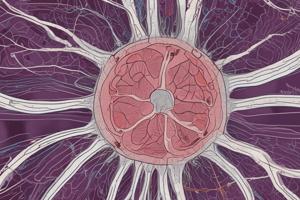Podcast
Questions and Answers
What are the principal constituents of the amorphous ground substance in connective tissue?
What are the principal constituents of the amorphous ground substance in connective tissue?
- Fibroblasts
- Collagen fibers
- Elastic fibers
- Glycosaminoglycans (correct)
Which cells are primarily responsible for secreting tropocollagen in connective tissue?
Which cells are primarily responsible for secreting tropocollagen in connective tissue?
- Fibroblasts (correct)
- Leukocytes
- Macrophages
- Adipocytes
What is the primary function of blood in the connective tissue category?
What is the primary function of blood in the connective tissue category?
- Storage of fat
- Transport of oxygen and nutrients (correct)
- Protection against infection
- Support for internal organs
What role does migration play in tissue health?
What role does migration play in tissue health?
Where is areolar tissue mainly located?
Where is areolar tissue mainly located?
What is the primary function of lymph in the body?
What is the primary function of lymph in the body?
What type of connective tissue consists of cells filled with lipids?
What type of connective tissue consists of cells filled with lipids?
What results from the lack of cell migration during tissue repair?
What results from the lack of cell migration during tissue repair?
What are the main components of connective tissue?
What are the main components of connective tissue?
Which type of fibers is most abundant in connective tissue?
Which type of fibers is most abundant in connective tissue?
How do the proportions of connective tissue components vary?
How do the proportions of connective tissue components vary?
Which of the following is NOT considered a type of connective tissue fiber?
Which of the following is NOT considered a type of connective tissue fiber?
What is the primary role of ground substance in connective tissue?
What is the primary role of ground substance in connective tissue?
Where is connective tissue found in the body?
Where is connective tissue found in the body?
What is a characteristic of loose areolar connective tissue fibers?
What is a characteristic of loose areolar connective tissue fibers?
What distinguishes specialized fluid connective tissues like blood from other connective tissues?
What distinguishes specialized fluid connective tissues like blood from other connective tissues?
Flashcards are hidden until you start studying
Study Notes
Structure and Function of Connective Tissue
- Connective tissue supports organs and cells, transports nutrients and wastes, defends against pathogens, stores fat, and repairs damaged tissues.
- Composed of an extracellular matrix, limited cells, ground substance, and specialized fluid connective tissues like blood and lymph which lack fibers.
- Organized into subcategories based on nonliving components' placement and arrangement in the body, integrating throughout tissues including the nervous system.
Components of Connective Tissue
- Extracellular Fibers: Include collagenous, elastic, and reticular fibers, with collagen being the most abundant type.
- Ground Substance: A transparent material resembling a viscous solution or hydrated gel, primarily consists of glycosaminoglycans (formerly mucopolysaccharides).
- Cells: Comprised of stationary fibroblasts, essential for secreting tropocollagen and maintaining extracellular components, along with migrating cells important for tissue changes, regeneration, or inflammation.
Types of Migration in Connective Tissue
- Migration aids tissue morphogenesis, regeneration, and inflammation; disruptions can lead to diseases such as autoimmunity and cancer.
- Failure in migration often contributes to ineffective regenerative therapies, particularly with stem cells.
Types of Connective Tissue
-
Blood
- Location: Inside the closed circulatory system.
- Structure: Contains erythrocytes, leukocytes, and platelets suspended in liquid plasma.
- Function: Transports oxygen, nutrients, hormones, and wastes.
-
Lymph
- Location: Surrounds cells throughout the body.
- Structure: Fluid derived from blood capillaries, rich in leukocytes and liquid ground substance.
- Function: Protects the body from infections.
-
Areolar Tissue
- Location: Found between skin and muscles and around blood vessels.
- Structure: Composed of various cell types loosely arranged within a jelly-like ground substance and elastic fibers.
- Function: Provides support to internal organs.
-
Adipose Tissue
- Location: Situated below the skin and around internal organs.
- Structure: Made up of cells filled with fat, functioning mainly as energy storage and insulation.
Studying That Suits You
Use AI to generate personalized quizzes and flashcards to suit your learning preferences.




